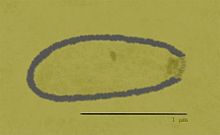Pithovirus sibericum
| Pithovirus sibericum | |
|---|---|
 |
|
| Virus classification | |
| Group: | Group I (dsDNA) |
| Order: | Unassigned |
| Family: | Pithoviridae |
| Genus: | Pithovirus |
| Species | |
|
|
Pithovirus, first described in a 2014 paper, is a genus of giant virus known from one species, Pithovirus sibericum, which infects amoebas. It is a double-stranded DNA virus, and is a member of the nucleocytoplasmic large DNA viruses clade. The 2014 discovery was made when a viable specimen was found in a 30,000-year-old ice core harvested from permafrost in Siberia, Russia.
The genus name Pithovirus, a reference to large storage containers of ancient Greece known as pithoi, was chosen to describe the new species. A specimen of Pithovirus measures approximately 1.5 µm (1500 nm) in length and 0.5 µm (500 nm) in diameter, making it the largest virus yet found. It is 50% larger in size than the Pandoraviridae, the previous largest known viruses, is larger than Ostreococcus the smallest eukaryotic cell, although Pandoravirus has the largest viral genome, containing 1.9 to 2.5 megabases of DNA.Pithovirus has a thick, oval wall with an opening at one end. Internally, its structure resembles a honeycomb.
The genome of Pithovirus contains 467 distinct genes, more than a typical virus but far fewer than the 2556 putative protein-coding sequences found in Pandoravirus. Thus, its genome is far less densely packed than any other known virus. Two-thirds of its proteins are unlike those of other viruses. Despite the physical similarity with Pandoravirus, the Pithovirus genome sequence reveals that it is barely related to that virus, but more closely resembles members of Marseilleviridae, Megaviridae and Iridoviridae. These families all contain large icosahedral viruses with DNA genomes. The Pithovirus genome has 36% GC-content, similar to the Megaviridae, in contrast to greater than 61% for pandoraviruses.
...
Wikipedia
